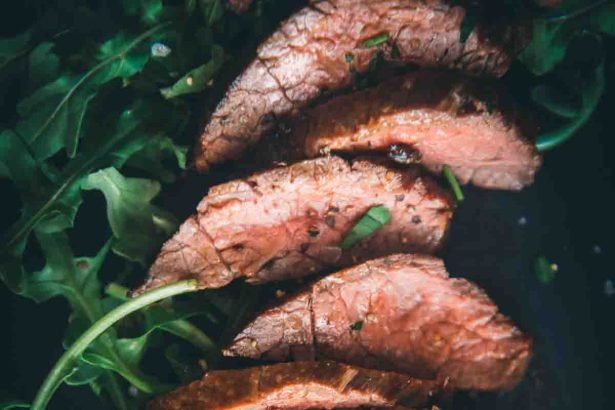Sink your teeth into the delectable pan-seared Sierra steak, an underrated gem that promises a burst of rich, beefy flavors with every juicy bite. This guide will walk you through the simple technique of pan-searing for that perfect crust and juice medium rare center.
Chances are, you’ve never seen this delicious cut of steak on any restaurant menu and are wondering what it is and how to cook it. Well, you’re in luck.
If you’re looking to elevate your steak recipes, pan-seared Sierra steak is a unique cut that is sure to spark some curiosity from friends and family when served. With its tender and juicy texture, combined with a mouthwatering crust that forms during the searing process, this dish is sure to impress both yourself and any guests lucky enough to try it.
The Cut: What is Sierra Steak
The Sierra steak is a cut of beef from the top of the chuck primal, the shoulder area of the cow. This primal is a well-worked part of the animal but has a bold, beefy flavor, similar to a flat iron steak or another of our favorite type of steak, the Denver steak.
This steak, isn’t often found at your local market because it takes a skilled butcher to remove the small steak from between the seam of the chuck eye roll and under blade. We buy our steaks online from our favorite purveyors when we want a special meal, but always check your local butcher shop first if you have one nearby.
Also known as the chuck flank, the Sierra cut is similar to the flank steak or skirt steak, with a thin fine visible grain running at an angle through the cut. Though, it’s more petite in weight and size. With minimal fat or marbling, it is an incredible lean steak that benefits from a quick steak marinade to tenderize it. And should be cooked hot and fast, whether pan-seared in seasoned cast iron, grilled hot and fast, or broiled.
Ingredients
- Sierra Steak
- All Purpose Steak Marinade
- Canola oil or unsalted butter
- Kosher salt and freshly ground black pepper
- Compound butter to finish
- Horseradish cream sauce for serving
How to make pan-seared Sierra steak
Start by removing the steak from the package and patting it dry with paper towels.
Then add it to a baking dish or resealable bag and pour the steak marinade on top. Seal the bag, or cover the dish, and place it in the fridge for 2 hours.
When ready to cook, remove the steak from the marinade and pat it really dry. It’s the dry steak in the hot pan that causes the Maillard reaction, creating that beautiful crust we all love.
Preheat your clean cast iron pan over medium-high heat until just smoking, and add the oil. Swirl to coat the pan, then place the steak in and sear quickly on all sides.
Because this is a thin, small steak, it cooks quickly. Flip it often with long tongs for even browning on all sides, and use n instant read thermometer to check the internal temperature. We remove ours from the heat at 125 F for the perfect medium rare steak doneness. Because this is such a lean cut of steak, cooking it past medium can cause it to become tough and dry.
When done cooking, place a dollop of garlic herb compound butter over the top of the Sierra steak and tent it with foil. Let the steak rest for 5 to 10 minutes before slicing into it.
Just like slicing a flank steak, cutting against the grain is important for the best bite with this cut. Find the grain and rotate the steak against the grain on a bias into thin strips. Sprinkle the steak with a little flaky salt and pepper and serve it immediately.
What to serve with Sierra steaks
Serve your steak dinner with homestyle mashed potatoes, smoked cabbage, fresh grilled asparagus, or any of your favorite savory side dishes.
Wine Pairing
This steak can handle the boldest of red wines, and we love pairing it with a GSM or a Syrah.
Leftovers and Storage
You probably won’t have any leftovers of this tiny steak, but if you do, wrap it tightly in foil with reserved juices and heat it up the next morning in scrambled eggs or breakfast burritos.
This steak can last up to 3 days in the fridge. Use caution reheating it as it quickly drys out.






